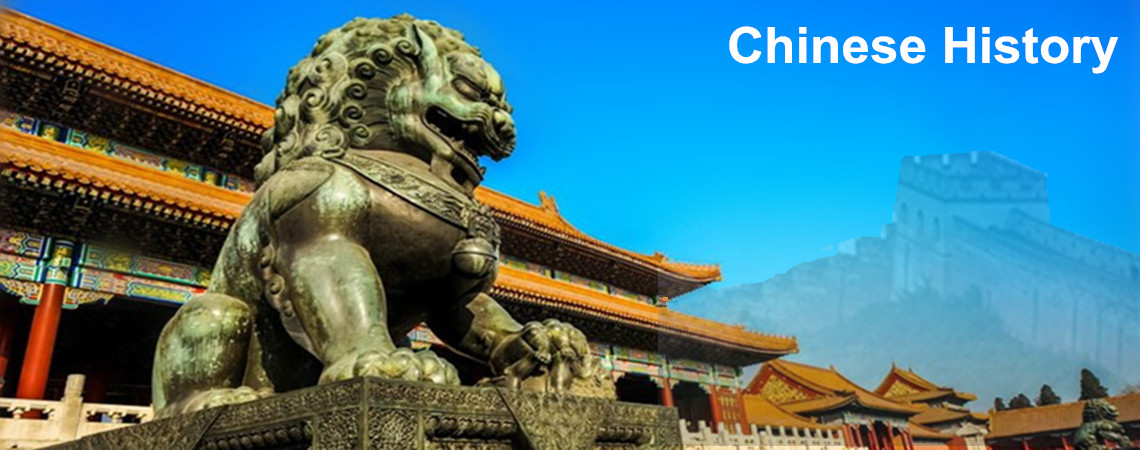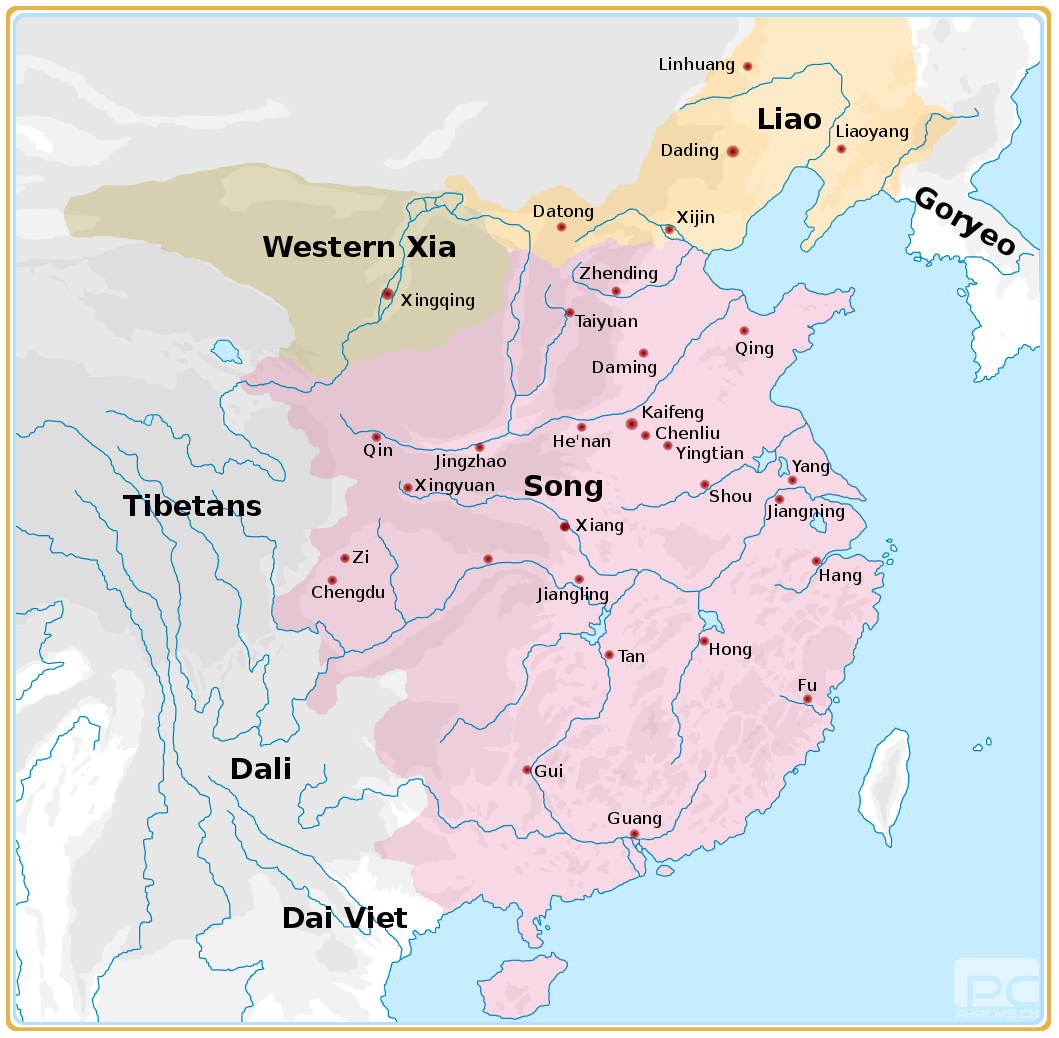
Northern Song Dynasty(960 -1127)
The Northern Song was founded by Zhao Kuangyin, a military general in the Latter Zhou (951 - 960). In 960, Zhao Kuangyin launched a mutiny in Chenqiao county (in current Henan Province).It was not long before the last king of the Latter Zhou was forced to abdicate. Thus a new dynasty - Song was established in Kaifeng. In that period, most part of China's territory was unified. However, in late Northern Song, the political corruption was serious and the regime began to decline. In 1127, it was destroyed by the Jin (1115 - 1234).
Facts of the Northern Song Dynasty
Time: 960 -1127 ( Ended by the Jin Empire)
Location of Capital: Kaifeng
Emperors: Gaozu, Taizong...
Replaced by: Southern Song Dynasty
 The Northern Song Dynasty (960-1127) was smaller than the Tang empire. It didn't control an area of Central Asia that was controlled by the Tang empire.
The Northern Song Dynasty (960-1127) was smaller than the Tang empire. It didn't control an area of Central Asia that was controlled by the Tang empire.
Facts of the Northern Song Dynasty
Time: 960 -1127 ( Ended by the Jin Empire)
Location of Capital: Kaifeng
Emperors: Gaozu, Taizong...
Replaced by: Southern Song Dynasty
 The Northern Song Dynasty (960-1127) was smaller than the Tang empire. It didn't control an area of Central Asia that was controlled by the Tang empire.
The Northern Song Dynasty (960-1127) was smaller than the Tang empire. It didn't control an area of Central Asia that was controlled by the Tang empire.Emperor Taizu ( Ruled 960-976)
Emperor Taizu, known as Zhao Kuangyin,Established Song Dynasty in 960.
Zhao Kuangyin, a military general in the Latter Zhou (951 - 960). In 960, he launched a mutiny in Chenqiao county (in current Henan Province). It was not long before the last king of the Latter Zhou was forced to abdicate. Song Dynasty was established in Kaifeng.
Unified China
In that period, most part of China's territory was unified.During his 16 years of rule, he instituted successful policies and won his wars of expansion.In the beginning of the Song era, the land under rule only covered the areas of the Yellow River and the Huai River. In the north, there were the Northern Han and Khitan kingdoms; in the west, there was the Later Shu Kingdom; in the south, there were the Southern Tang, Wuyue, Jingnan, and Southern Han kingdoms.
Valued Literati
Emperor Taizu adopted his chancellor Zhao Pu's idea that the whole conquest should be carried out in order of difficulty. Emperor Taizu valued Confucian literati throughou this life. After he took the throne, civil officers were sent to thousands of local, county, and state positions to displace the military officers.
By doing so, the situation of local warlords possessing too much power and rebelling frequently during the later period of the Tang Dynasty had been changed.
Keju Examination
Emperor Taizu set the policy that most of the governing officials should be Confucian literati who passed the imperial exam, which was known as the Keju examination in ancient China. Thanks to this policy, many ordinary people became officials by studying hard. This policy helped to ensure that the officials were very intelligent and loyal to the government.
Emperor Taizong (Ruled 976–997)
In 976, Emperor Taizu died suddenly and his younger brother, Zhao Kuangyi, took the throne. He later changed his name to Zhao Guangyi and named himself Emperor Taizong.
Unified the Country
In 979, Emperor Taizong sent a general to besiege the capital of the Northern Han and then led the troops personally before conquering the Northern Han completely. This campaign eventually ended the Five Dynasties and Ten Kingdoms Period.
Developed Religion
In 980, Emperor Taizong set up a sutra translation institution in Dongjing (modern-day Kaifeng) and continued the Buddhist text translation work, which had been interrupted from 811.
During his reign, he also constructed many Buddhist temples.
Wars With other Ethnic Tribes
For about 150 years, the result of the Song wars was stalemate. They couldn't conquer their neighbors, but they didn't lose significant territory to them either. Therefore,they kept their territory integrity until 1127.
War Against the Western Xia
Western Xia was a small kingdom in the northwest that controlled access to the strategic Gansu Corridor. The Song Dynasty thought that if they could regain the land of the Western Xia, they could perhaps reestablish the lucrative Silk Road trade that benefited the Han and Tang dynasties.But this expedition was a disaster for the Song empire, and the Western Xia regained territory they had earlier lost.
War Against the Viets
The Song court wanted to annex the Viet territory. The Ly Dynasty behaved as vassals, but the Song court thought that the country was weak enough to conquer. In response, the Ly Dynasty sent an army of about 100,000 soldiers to Nanning and soundly defeated three Song armies. From 1075 to 1077, the Ly Dynasty in Vietnam fought them. This war also ended in a stalemate. Captives and captured land were mutually exchanged.
War Against the Liao Empire
The Liao empire in the northeast was an aggressive military threat to the Song empire. In 1004, the Song Dynasty managed to win several military victories over the Liao, and then the Liao sought peace. The two parties signed a peace treaty, which was known as the Chanyuan Treaty. The Northern Song Dynasty sought to defeat the Liao. They allied themselves with the Jin and started a war that ended in disaster for them.
The combined armies defeated the Liao empire, but then the Jin turned against the Song empire and captured Kaifeng, the Song capital city. They captured Emperor Hui (ruled 1100–1125) and Emperor Qin (ruled 1125–1127) as well as much of the ruling clan in 1127, which was known as the Jingkang Incident.






 Ask Questions ?
Ask Questions ?